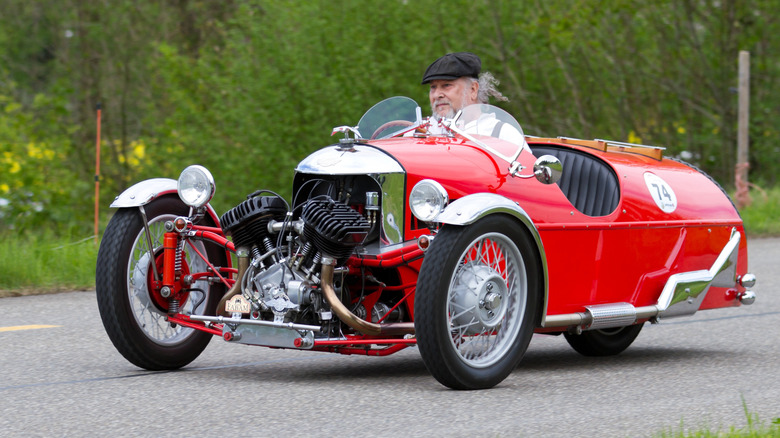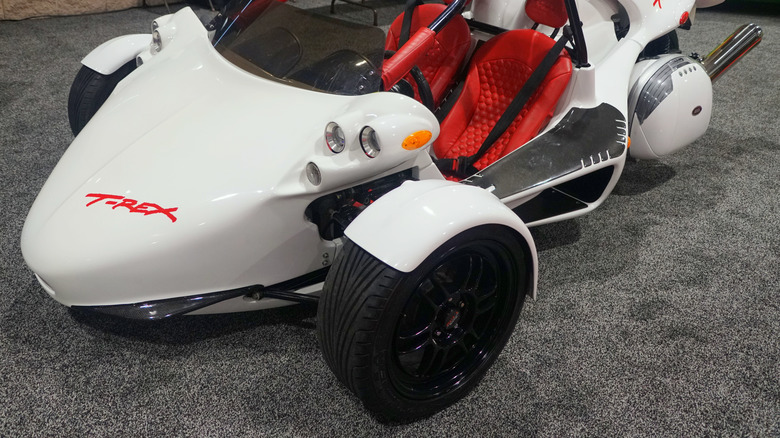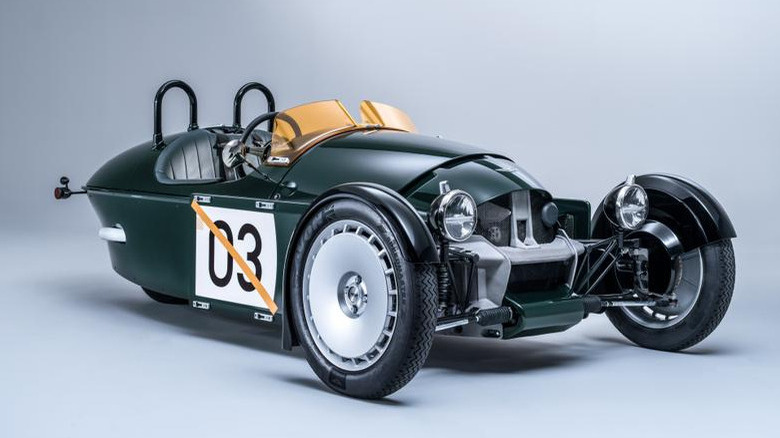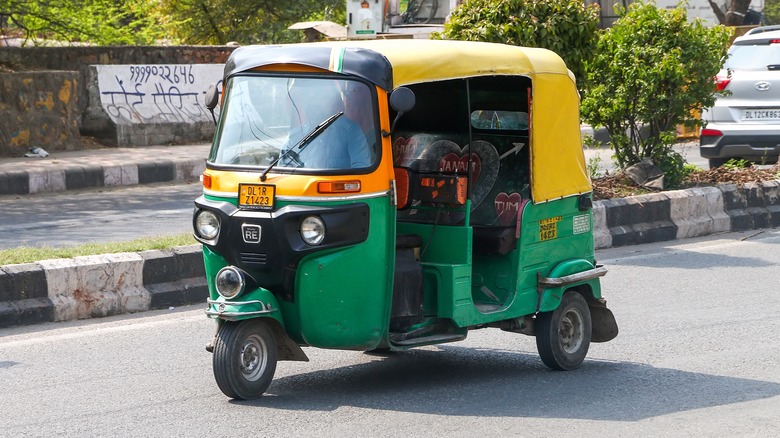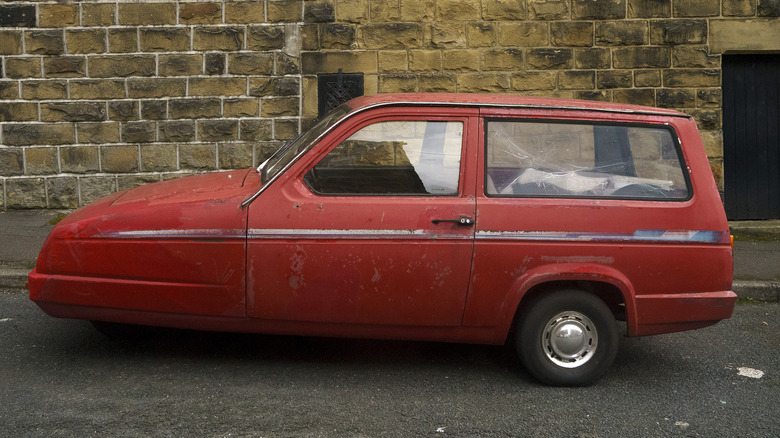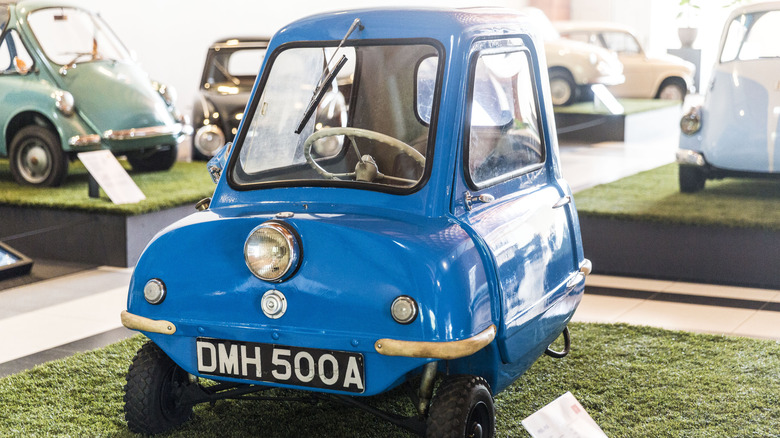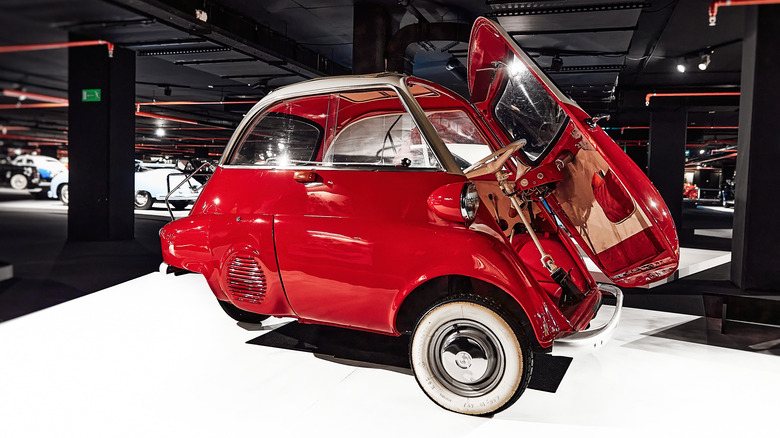The 5 Best And 5 Worst 3-Wheeled Cars On The Market
The very first car, whether that is said to be the steam vehicle by Joseph Cugnot or Karl Benz Patent Motorwagen, moved precariously on just three wheels. The decision to use three wheels on those vehicles was made for reasons of practicality. But as the automotive industry matured, we quickly discovered that four-wheel conveyances are superior for many reasons. Four wheels offer better stability and allow the front wheels and rear wheels to track through the same ruts or tracks on a road. Yet some plucky and clever automakers have continued to build cars based on the power of three.
While they will never enter the mainstream, three-wheeled cars are available and some of them are rather capable and innovative products. They can be a mix of car and motorcycle-derived engines and drivetrains and some are all-electric. Still, some of these machines are probably better if they did not exist. Some three-wheeled cars may be clever and novel but essentially pointless and probably miserable to drive. Like so many other products the quality of three-wheelers runs across a spectrum and many of them are no longer in production, but that does not mean they cannot be bought on the used market. So this list includes five good and five bad three-wheelers that can currently be purchased.
Vanderhall - Best
The Vanderhall is an interesting and cool little ride and the company is relatively new. The vehicle produced is set up and constructed differently from the leaders in this segment, and its innovation adds to its overall desirability. The most unique feature of the Vanderhall is its drivetrain. Vanderhall offers two models that are variations on the same chassis. They are driven by a 1.5-liter turbocharged inline 4-cylinder engine with a six-speed automatic transmission turning the front wheels, according to GM Authority. This makes the Vanderhall distinctly different from other rides with engines derived from motorcycles.
The styling of the Vanderhall has a classic kind of feel with curves and understated lines. This continues inside where the dashboard would not look out of place in a 1930s coupe, complete with toggle switches and analog gauges. The classic look does not translate to the specs as everything else on the Vanderhall is very much up-to-date as it includes direct injection, a Bluetooth stereo, disc brakes on all wheels, and a nicely appointed leather interior, according to Cruiser. The biggest drawback to buying a Vanderhall is the price, as the range starts at around $30,000, which is an awful lot of money for a vehicle that is essentially a toy.
Campagna T-Rex - Best
The T-Rex is a sort of Canadian beast built by hand in Montreal and is powered by a 200-horsepower Kawasaki engine. It has got sleek looks, plenty of power, and sharp handling. Campagna has been making these unique machines for more than a decade and, according to Motor Trend, they are an absolute blast to drive, but not as much fun to get into as the passenger space is rather cramped.
With the extremely lightweight chassis and minimal body paired to the same engine as found in the latest Ninja motorcycle, it is quick. The manufacturer boasts that the newest T-Rex is now equipped with traction control, a good feature to keep from spinning the lone rear tire into a cloud of smoke. It also has an adjustable suspension and the T-Rex is capable of taking up to 1.3G in lateral acceleration if you can stomach it. The biggest figure on the Campagna website is also the toughest to stomach though. The newest T-Rex retails for around $60,000. You could buy two Vanderhalls or an Audi A6 for the same money.
Polaris Slingshot - Best
Among the three-wheelers, the Slingshot is probably the best know in North America. Produced by motorsports powerhouse Polaris, it has the backing of a long-established company for service and support, giving buyers peace of mind for the long-term prospects of ownership. The Slingshot has the most aggressive styling of all and it's full of sharp creases, angles, and bright colors. Polaris offers this vehicle a 2.0-liter 4-cylinder engine producing either 178 horsepower or 203 horsepower in top trim levels. Otherwise, they are fairly well equipped with antilock brakes, traction control, and an optional robust infotainment system.
We had a chance to take one out and found a lot of good things to say about it. The Slingshot is fun to drive and really feels at home with stretches of road in front of you. Stoplight traffic is stifling with such a good power-to-weight ratio. Slingshots have the power of a mid-level hatchback but weigh about the same as a Great Dane, and the handling lets you turn on a dime, daring you to try and give it a flip. It is impractical in every way, but it's not meant to be and anyone who buys one expecting any utility from it is a fool. Our reviewer was most impressed by the Rockford Fosgate-supplied audio system. Of these modern sporty three-wheelers, the Polaris is the most affordable with the base model coming in at just over $20,000. It still is not cheap and it still is a toy, but worth considering if you can afford it.
Morgan - Best
Morgan has been making three-wheeled vehicles for more than a century. Obviously, it is the most well-established of these companies and its vehicles are known around the world. It is an icon of the British motoring world but remains a niche, low-volume manufacturer and that means that Morgans are not often seen on the road. Being a unique, low-volume car also means that they will turn heads everywhere they go and probably attract a fair bit of attention at local car shows.
Historically, many Morgan 3-Wheelers have had motorcycle v-twins to power them. This was true until the previous model ended in 2018, which was powered by an American S&S engine, according to the manufacturer. The current Morgan is all-new and takes the car in an all-new direction with modern styling and even more modern equipment. Gone are the classic look and the old v-twin hanging out upfront. They have given way to a modern Ford 3-cylinder engine and a cockpit filled with digital screens and USB ports. We reported that the new one is built on an all-aluminum monocoque chassis that is light and rigid and that this is Morgan's first all-new design in more than two decades.
Priced at around $47,000, the Morgan Super 3 sits in the middle of the range of the mainstream three-wheeled cars. It may be the best value considering the brand's heritage and longevity as well as having a known reliable power plant. Regardless, it is still a very expensive toy, but maybe not bad for use on track days.
Bajaj RE - Best
Bajaj is not a name that many on the North American continent will be familiar with but on the Indian subcontinent, it is a manufacturing giant. The company started as an importer of Vespa motor scooters shortly after independence from Great Britain and later went on to produce its own line of scooters under license from Piaggio. It has since become one of India's largest vehicle manufacturers and one of its best-selling products is the three-wheeled scooter-based RE, often referred to as a tuk-tuk.
The Bajaj RE may not be the obvious choice for the best three-wheelers to most, but it has to be checked out in context as they are the prime mode of transportation for nearly a billion people in India and its neighboring countries, such as Pakistan and Bangladesh. With power ratings of less than 10 horsepower, the Bajaj RE in pickup format is rated from the factory with a payload capacity of 1500 pounds, an impressive amount from such meager machinery (via Bajaj Auto). They are also the most common taxi in India and are ubiquitous on the roads in all corners of the country as they are tough, reliable, and low-maintenance.
For a vehicle to fulfill its purpose is the ultimate test of how good it is. If the Bajaj RE is meant to get Indians on the move and haul their goods to and from market, then the RE is a success. Any visit to India shall surely include a ride in one and the opportunity to see the city in the most Indian manner possible.
Reliant Robin - Worst
Strict safety requirements, emissions regulations, and cultural preferences of the United States have prevented a great many vehicles from making it onto our shores for many years. This has deprived us of fantastic sports cars that remain highly desirable and coveted but also have kept away some less than desirable machines. That includes the Reliant Robin. While there may be some weirdos who just love to tinker with strange and foreign cars from other markets, the Robin was never officially sold in the States.
Reliant has a long history of manufacturing three-wheeled cars, but the Reliant is probably the best known as well as being the most recently built. It doesn't hurt that it featured prominently on an episode of Top Gear with Jeremy Clarkson mucking about and rolling it all willy-nilly. The Robin is actually more stable than the video lets on, but it is not much of a car.
Built with a fiberglass body on a steel frame, the Robin is geared up with an 850cc engine sitting behind the lone front wheel and not much else, according to Jalopnik. It has wipers, turn signals, and seats. There are no creature comforts besides a heater, and safety protection is nil. It is ugly but the cargo space is better than expected so it may have a single redeeming feature. They can still be bought in the UK for a few thousand pounds, but, aside from desperation, finding reasons to buy one may be tough.
Peel P50 - Worst
Hailing from the Isle of Man in the middle of the Irish sea is the Peel P50, which is said to be the smallest production car ever made. Looking at it, it is hard to disagree. The P50 has enough room for one person, barely, and offers minimal protection from the elements. The Peel offers minimal car in general. For someone who wants to own a piece of curios history and have a toy to bring out every once in a while, the P50 is fine. For anyone who wants a vehicle, even as a weekend toy, and drives it often, the P50 is terrible.
The Peel was made in the early sixties and only managed to produce 49 in total. It is powered by a 49cc DKW scooter engine, providing a whopping 4.5 horsepower. It's got 3 forward gears and the reverse is handled literally by a handle. You must lift up the rear and turn it in the direction you want to go (via BBC). Such niceties as climate control and electric start are pipe dreams for this car as well.
For reasons unknown, someone has decided to make new models. Since there were only 49 made in the first place, a dearth of tiny and useless cars drove up the prices and it seemed somehow to be necessary to create more for someone to drive for some reason, presumably. In the end, it's an oddity that is impractical in every way and should not be driven ever.
Chinese 3 Wheel car - Worst
In the past two decades, the manufacturing base of China has exploded and the country has been making all manner of products, especially in the transportation sector. This includes what seems to be an unlimited supply of weird, cheap three-wheeled cars. The information on them can also be kind of hard to track down, so all of them are right to fit into one slot together.
It seems with so many of these cheap Chinese products that the name brand has no meaning at all and that zero pride is put into the manufacture. So long as it leaves the factory and looks to be at least a resemblance to what was promised, it ships. A quick search on Alibaba delivers dozens of terrible-looking little electric three-wheel cars such as this. It can be had for as little as $890 if you buy at least 5. Single orders are only $1550. When considering that materials had to be bought and workers paid to assemble this, and then there must be a profit for the manufacturer and the wholesaler, the total cost to make this thing could be as little as $500. Is it prudent to trust a vehicle that can move down a road that costs so little to manufacture? Probably not.
So this is for all the junk on Alibaba and Made-in-China and all the other random generic Chinese vehicle websites out there. They are the worst three-wheeled cars made.
Bond Microcar - Worst
During the postwar period in Europe people needed to get around, but the economies of the various countries were in shambles and affordable transportation was desperately needed. This situation gave rise to many small car makers, including Bond and its Minicar. The Bond is really the most ridiculous three-wheeled car but its postwar styling makes it undeniably endearing. It seems like it would be a fun little thing to keep around, but the reality of driving it is that it is downright terrible.
These little cars were built in the north of England and the most popular model, the Mark C, was powered by a 2-cylinder motorcycle engine with a total power output of a grand 8.5 horsepower, according to Hemmings. They are front-wheel-drive – that means one-wheel-drive – and driven by a chain through three-speed sequential transmission. Under the bonnet is found the engine drives the front wheel directly through a chain and the entire assembly turns together. It is a bizarre setup but it did not prevent about 24,000 of them from being sold.
Viewing any number of YouTube videos of these cars you can see just how basic and miserable the driving experience really is. However, they are interesting little collectible cars and that does lead them to still go up for sale at auction and make for very affordable entry-level collector cars. Just don't drive them and they make a fine collectible auto.
BMW Isetta Export Model - Worst
Most eagle-eyed classic car buffs might see the Isetta on this list and immediately proclaim its inclusion to be erroneous as everyone knows the Isetta has four wheels, not three. This is true that the BMW Isetta was made with two closely spaced wheels on the rear for added stability. However, it was also exported to Great Britain with just three wheels to avoid the tax and licensing requirements of a car. So, while very rare, a three-wheeled version does exist. And if the typical Isetta is a terrible car, losing one of its wheels can only make things worse.
Born out of a need for cheap transportation after the war, the Isetta met that need, barely. With room for two and a 300cc four-stroke motorcycle engine, the Isetta barely covered its occupants and barely moved them along, uncomfortably. The front of the car doubles as the only door, and the roof is canvas so that, in the event of an accident, occupants can climb out through the roof. The three-wheeled, right-hand-drive versions of the car were built in Brighton from 1957-64, according to Hagerty.
A proper test drive would be needed to get to realize why this is such a terrible car. The size and makeup of it should be enough of a tip-off, though. But since they are fast gaining in price on the collector car market, watching a Youtube video shall suffice. YouTuber Doug Demuro drove a four-wheeled example in one of his reviews and not only does he demonstrate the many issues with the Isetta, but it also fails to go up a hill entirely.
